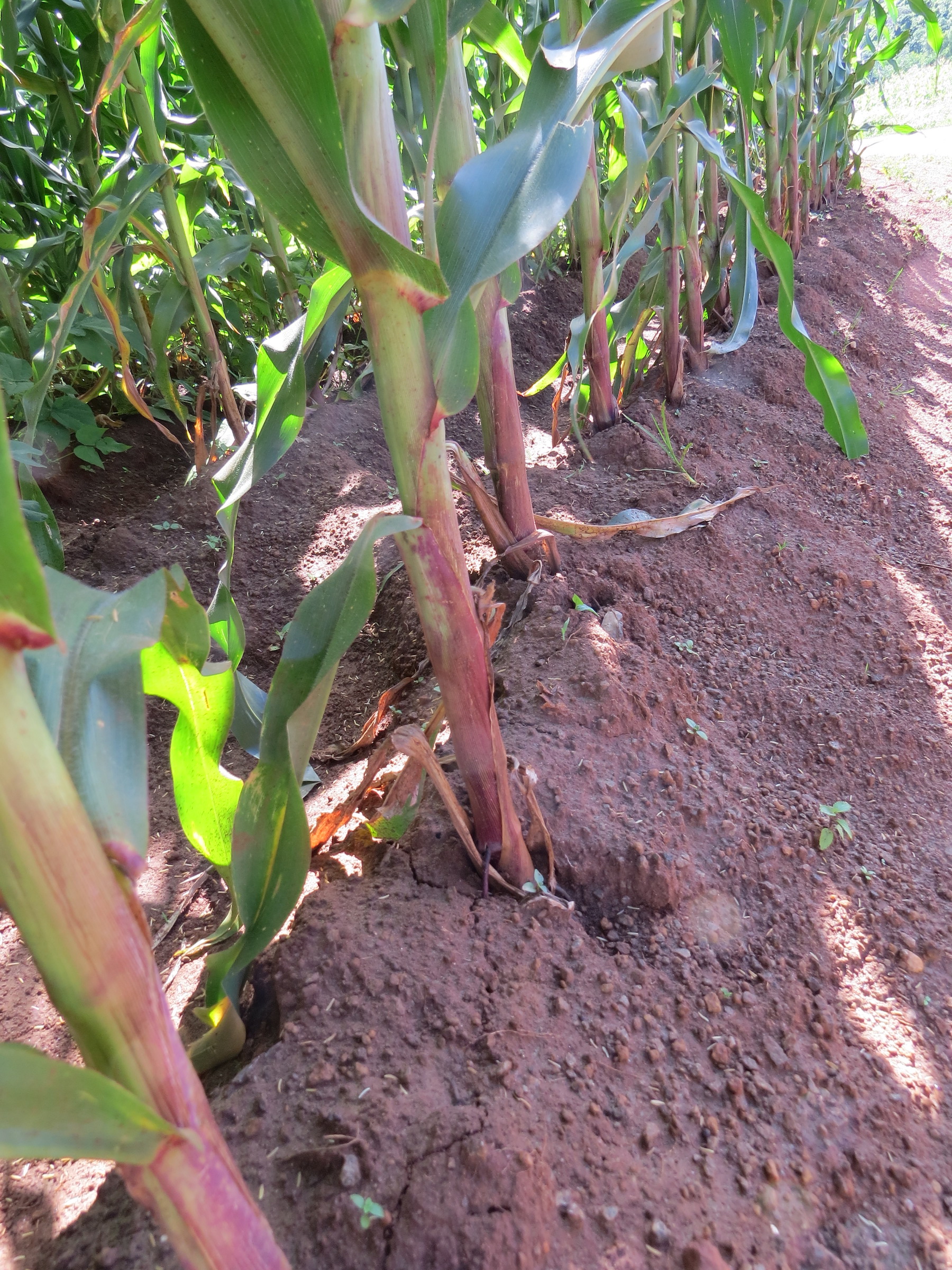Phosphorus- The Key to Sustainable Nutrient Management
 Description
Description
Phosphorus (P) is one of three primary macronutrients (NPK) essential to plant and crop productivity. It is considered a macronutrient, as opposed to a micronutrient, because it is required in large quantities and is essential to multiple plant productivity processes. In order to maintain and/or improve sub-Saharan African smallholder crop productivity, phosphorus must be supplied in a sustainable manner. Below we explore the role of P in soil fertility and crop productivity, consider how it is currently recommended and supplied to smallholder farmers, and explore alternative biologically-mediated approaches that could improve productivity, profitability, and sustainability.
Our soil research in sub-Saharan Africa (SSA) generally focuses on the role of P and nitrogen (N) due their essential roles in crop production and their interdependent relationship. Additionally, other nutrients generally play minor roles in plant nutrition on smallholder farms (with notable special case exceptions where parent material is deficient in micronutrients). In fact, soil parent material and soil organic matter generally mineralize sufficient micronutrients to achieve two and three fold higher yields than current low yield levels in SSA. Producing very high crop yields and nutrient-enriched grain, on the other hand, involves choosing the right genetics (Cichy et al., 2009), and nutrient supplementation through substantial doses of manure and/or fertilizers. Our research, therefore, focuses on more immediately feasible approaches to improving smallholder productivity.
Phosphorus is essential to multiple plant growth processes including photosynthesis, respiration, and cell division (to name just a few). In fact, P is the key to energy transformations in all organisms. This includes the high-energy demanding process of biological N fixation by plants and their symbiotic microorganism partners. Plants are often responsive to P additions, although soil type and management history can vary across small distances and induce high variability in soil P status across a field, farm and region (Snapp, 1998; Tittonell et al., 2005).
Soil P supply to plants is a highly complex process, with both inorganic and organic P pools. What is available to plants is a minuscule P pool relative to the total amount of soil P (Hedley et al., 1982). This sparingly[1]-soluble, available P pool is regulated by complex factors such as the soil matrix, biology (including plants and associated microbially-mediated processes), and chemistry (Drinkwater and Snapp, 2007). Farming practices markedly influence P availability, through inputs and management that influence soil processes of precipitation-dissolution and sorption-desorption (Drinkwater et al., 2016). To understand the complex P cycle and the processes affecting availability of P to crops, we recommend reading this review of the P cycle and how it can be managed based on application of ecological principles (insert P cycle figure from Drinkwater).
To ensure P supply to plants in a sustainable manner careful attention must be paid to biological processes and how to manage them. Sustainable management depends on where system boundaries are drawn, as a ‘mass balance’ approach of replenishing nutrients removed is in essence advocating mining nutrients from one location to apply to fields in another location (Snapp, 1999). This includes both sources of P used by smallholder farmers in Africa: fertilizer, which is physically mined, and manure, which involves grazing over a large area to concentrate nutrients for field application (in many cases). There is growing interest in how to improve the efficiency of nutrient use, so as to minimize demand for finite resources such as phosphate rock deposits. Recycling of P and replenishing of pools that are available for plant uptake through biologically-mediated solubilization plays a key role in the efficiency of P use for agricultural production. Attention to soil organic matter and organic P pools has been understudied, given the major role such play in plant P nutrition on smallholder farms. We advocate for integrated nutrient management that considers soil carbon and biogeochemical processes in concert with P nutrition.
Here we outline practical, biologically mediated and targeted approaches that show potential to supply P to smallholder crop production. Legumes have root architectural traits, exudates and other properties to enhance P availability in support of the high-energy demands of N biological fixation (Ae et al., 1990; Bonser et al., 1996). In turn, legumes with an adequate P supply integrated into a farming system can reduce the requirement for external N and P (Gallaher and Snapp, 2013). As documented in a long-term field study, diverse management systems such as organic farming that rely on red clover and alfalfa for BNF as a primary N replenishment process are also incorporating species that have unique P solubilization properties.
Rotation and intercrop diversity is a major way to improve P efficiency. Pigeonpea is an exceptional example of a tropical legume with proven P-solubilizing properties and is a plant species that is highly suited to semi-arid to sub-humid tropical farming systems around the globe (Ae et al., 1990; Snapp et al., 2003). Another advantage pigeonpea has in releasing soil P stores is a long growth period, supporting seven or more months of time in which pigeonpea roots exude pscidic acid to chelate and release phosphorus into a plant-available pool. In addition to legumes, other highly mycorrhizal crop species have been proposed as a means to enhance P cycling efficiency (Drinkwater et al., 2016). This is, however, an area of under investigation, and as yet there are few proven examples of crop choice that can improve phosphorus-integrated management in the field.
The form and manner of P applied as manure or fertilizer are important to management and efficiency of P use. Applying P in a highly soluble fertilizer form in a targeted manner, specifically to the crop root growth zone, is a proven strategy for improving plant P uptake efficiency. This reduces the opportunity for P interaction with soil minerals and prevents occlusion whereby P becomes effectively unavailable to crops, and it maximizes the opportunity for root-surface area to interact with P. The use of micro-dosing fertilizer, which is ‘point applied’ to root zones, in combination with organic materials is an example of a highly appropriate application of this approach that fits the resources and goals of many smallholder farmers (Bielders and Gerard, 2015).
A more controversial approach is to apply sparingly-soluble rock phosphate. This is a slow release form of P that has been promoted as an environmentally-beneficial P source, with long-term sustainability implications (Buresh et al., 1997; Drinkwater et al., 2016). However, it involves transporting and applying large amounts of relatively unenriched rock. Costs tend to be high, and P release rate is influenced by the soil type and environment; observable crop response sometimes requires years.
Conclusion
In our view, the extent to which N and P nutrient cycles can be tightened is at the foundation of sustainability. We are just starting to understand some of the opportunities and challenges associated with harnessing biologically-mediated, slow processes such as soil carbon sequestration. Diversified cropping, organic inputs from compost, and longevity of living roots are promising ways to enhance sparingly soluble P pools for improved nutrition. We look forward to co-learning with farmers, scientists and agricultural advisors how to enhance ecological knowledge to manage the complex P cycle for food security and sustainable livelihoods.
[1] This pool of P involves forms that can be dissolved by chemical and biological weathering and related processes, and taken up by plants.
Principles:
- Improve P cycling efficiency and support sustainable production.
- A focus on integrated approaches to managing C, N and P together rather than solo use of micronutrients and fertilizers is recommended
- Agro-diversification to include plants with properties that enhance P-solubilization and cycle P efficiency
- Targeted application of P in microdoses and directly to plant roots as compost or as fertilizer
Debates:
- How to develop management recommendations that take into account the complex factors that influence P supply to crops. This includes soil biology, chemistry, and heterogeneity, complexity of crop rotation, management history, goals of farmers and profitability.
- Is plant genetic approaches such as improved crops or use of pigeonpea to unlock soil P reserves by enhancing P solubilization a sustainable approach, or will it accelerate soil ‘mining’?
- Under what circumstances and time frame are sources of P likely to be used in a sustainable and affordable manner? For example, can rock phosphate play a role in supplementation of soil P reserves, or is rock-P too bulky to be profitable?
Learning Lab Resources:
Bonser, A.M., J.P. Lynch and S.S. Snapp. 1996 Gravitrophic response to low P and root architectural traits in common bean. New Phytologist 132:281-288.
Cichy, K.A., G.V. Caldas, S.S. Snapp and M.W. Blair. 2009. QTL analysis of seed iron, zinc, and phosphorus levels in an Andean bean population. Crop Science 49:1742-1750.
Drinkwater, L.E. and S.S. Snapp. 2008. Nutrients in agroecosystems: Rethinking the management paradigm. Advances in Agronomy. 92: 163-186.
Drinkwater, L.E., M. Schipanski, S.S. Snapp and L.E. Jackson. 2016. Ecologically based nutrient management. In: S.S. Snapp and B. Pound (Eds.) Agricultural Systems: Agroecology and Rural Innovation for Development. Academic Press. Second Edition.
Gallaher, C. and S.S. Snapp. 2013. Organic management and legume presence maintained phosphorus bioavailability in a 17-year field crop experiment. Renewable Agriculture and Food Systems 30:211-222.
Snapp, S.S. 1999. Phosphorus and sustainability of sub-Saharan Africa smallholder farms. pp. 59-72. In J.P. Lynch, J. Deikman (Eds.) “Phosphorus in Plant Biology: Regulatory Roles in Molecular, Cellular, Organismic & Ecosystem Processes” American Society Plant Physiol., Rockville, MD, USA.
Snapp, S.S., R.B. Jones, E.M. Minja, J. Rusike and S.N. Silim. 2003. Pigeon pea for Africa: A versatile vegetable – and more. HortScience. 38:1073-1078.
References:
Ae N., Arihara J., Okada K., Yoshihara T., Johansen C. 1990. Phosphorus uptake by pigeon pea and its role in cropping systems of the Indian subcontinent. Science 248: 477-480.
Bielders, C.L. and B. Gerard. 2015. Millet response to microdose fertilization in southwestern Niger: effect of antecedent fertility management and environmental factors. Field Crops Research 171:165-175.
Buresh, R.J., P.C. Smithson, and D.T. Heliums. 1997. Building soil phosphorus capital in Africa. In: (Eds. Buresh, R.J., P. A. Sanchez and F. Calhoun) Replenishing Soil Fertility in Africa, Soil Sci. Soc. of Am. Special Publications No. 51.. Pp. 111-149, Madison, WI.
Cavigelli M. A., Thien S. J. 2003. Phosphorus bioavailability following incorporation of green manure crops. Soil Sci Soc Am J 67: 1186-1194.
Hedley, M.J., J.W.B. Stewart & B.S. Chauhan, 1982. Changes in inorganic and organic soil phosphorus fractions induced by cultivation practices and by laboratory incubations. Soil Sci Soc Am J 46: 970–976.
Lott, J.N.A, J.Kolasa, G.D. Batten, and L. C. Campbell. 2011. The critical role of phosphorus in world production of cereal grains and legume seeds. Food Security 3:451-462.
Tittonell, P., Vanlauwe, B., Leffelaar, P., Rowe, E., Giller, K., 2005. Exploring diversity in soil fertility management of smallholder farms in western Kenya – I. Heterogeneity at region and farm scale. Agric. Ecosyst. Environ. 110, 149–165.
Tags: Agricultural Economics, Agrobiodiversity, Agroecology, Agronomy, Climate Change, Soil Science, Sustainability Science
 Description
Description